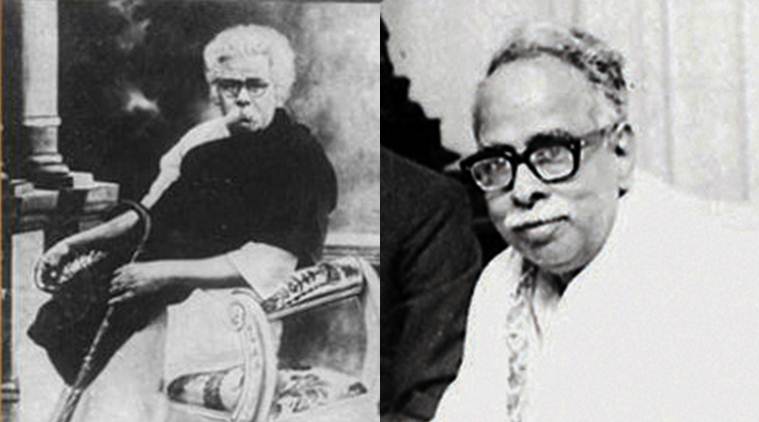 Periyar E. V. Ramasamy (left) and C.N. Annadurai (right)
Periyar E. V. Ramasamy (left) and C.N. Annadurai (right)
It has been 50 years since Dravidian rule began in Tamil Nadu in an attempt to overthrow the power status quo enjoyed by Brahmanism, Sanskrit language and the North Indian political elite. However, 50 years down the line, the state seems to have plunged into another political crisis. The ongoing power tussle and chaos in the ruling party since the death of party supremo J Jayalalithaa last December has left the grand project on social justice hungry for an organised leadership.
The crisis-hit All India Anna Dravida Munnetra Kazhagam (AIADMK), that is struggling to hold its ground between two factions — one led by O Pannerselvam and the other by VK Sasikala — owes its inception to the anti-Brahmin movement that took centrestage in South Indian politics in the 1930s-50s. Started by Periyar E. V. Ramasamy, the Dravidian movement was a novel populist project that drew strength from a class of people in pre-independent India, living in fear of north Indian and Brahmin domination. Reviving the supremacy of the Tamil language, upholding the purity of the Dravidian race and promoting regional nationalism, were some of the foremost motives of the movement.

Since 1967, when the Dravida Munnetra Kazhagam (DMK) came to power in the state under M. Karunanidhi, Dravidian politics has been in power alternatively under the DMK and its splinter organisation AIADMK. Before the DMK, Dravidian thought was upheld by political parties like the Justice Party and the Dravidar Kazhagam (DK). However, all of these parties ultimately originated from Periyar’s philosophy and the current state of politics in Tamil Nadu is a product of a long history of splits and re-splits of one broad political thought.
The Justice Party and Dravidar Kazhagam
The first organisation to uphold an anti-Brahmin ideology was the Justice Party established in 1917 by T. M. Nair and P. Theagaraya Chetty. In its initial years, it was concerned with the larger representation of non-Brahmins in the government. In 1937, Periyar E. V. Ramasamy took over the reigns of the Justice Party and made it a part of his Dravidian movement, by establishing it as the Dravidar Kazhagam.
 Funeral of Periyar. (Wikimedia Commons)
Funeral of Periyar. (Wikimedia Commons)
Eradication of the caste system and untouchability and promotion of a culture of rational debate were the foremost goals of the DK. Their activities included the entry of Dalits into temple premises, urging Brahmin priests to recite hymns in Tamil instead of Sanskrit and anti-Hindi agitations. However, the DK was not a full fledged political party ever. Even when several of its members desired to contest elections, Periyar discouraged them on the grounds that an entry into politics would push the ideology into the background. Overtime a large number of disputes arose between the party members and Periyar, especially after his marriage as he appointed his much younger wife as successor. In 1949, few of his followers led by C.N. Annadurai split away from the party and formed the Dravida Munnetra Kazhagam (DMK).
Dravida Munnetra Kazhagam (DMK)
Under the leadership of writer and playwright Annadurai, the DMK promoted the cause of a casteless society. Its main target was the Congress-led government in the centre which it saw as an upper caste organisation and promoted the cause of the suppressed castes, urging them to be a part of a secular Dravidian ideology.
Once the DMK won the state elections in March 1967 under the leadership of M. Karunanidhi they established an era of Dravidian rule that has remained in place till date. While taking a strong anti-centre stance against the Indira Gandhi regime, the DMK went about governance through a strong element of populism. The DMK for the first time established the roots of a welfare state like administration which would go on to define Tamil Nadu’s governance structure. The distribution of cheap rice, housing for the poor and nationalised transport are some of the measures taken by the government.
 Once the DMK won the state elections in March 1967 under the leadership of M. Karunanidhi they established an era of Dravidian rule that has remained in place till date. (ExpressArchives)
Once the DMK won the state elections in March 1967 under the leadership of M. Karunanidhi they established an era of Dravidian rule that has remained in place till date. (ExpressArchives)
The one other phenomenon made popular by the DMK government was the infusion of Tamil cinema and politics. Consisting of a large number of people from the film industry, the DMK for the first time made use for cinema for political propaganda. The trend of combining cinema with politics received its strongest boost when the film star MGR stepped into the DMK. As part of the DMK, MGR became the link between state politics and the common man and he made full use of his stardom for political success.
However, with the death of Annadurai relations between MGR and Karunanidhi started turning bitter. The latter was particularly accused for his high handedness and corruption. MGR’s protest against Karunanidhi’s ‘dictatorial methods’ resulted in him exiting the party and forming the AIADMK in 1972, thereby marking a whole new phase in Dravidian politics.
All India Anna Dravida Munnetra Kazhagam (AIADMK)
By the time the AIADMK was formed, MGR was a shining public figure, both as an actor and as a politician. His role as AIADMK chief and the chief minister of Tamil Nadu marked the beginning of a phase of deification of political leaders. MGR’s popularity in Tamil Nadu was at a level that was unheard of before. He went on to make sweeping victories in several elections. In 1977 he won the state assembly and remained chief minister till his death in 1987.
 AIADMK propaganda Secretary Ms Jayalalitha presenting a sceptre to CM MGR on behalf of the party headqurters (Express archive photo).
AIADMK propaganda Secretary Ms Jayalalitha presenting a sceptre to CM MGR on behalf of the party headqurters (Express archive photo).
While welfare measures began under the Karunanidhi-led DMK, under MGR’s AIADMK the populist formula was of a kind that paid no attention to state economic resources. He broadened the party’s support base by including poorer people. MGR’s welfare measures resulted in a severe drain of state finances and resulted in a rise in leftist militancy. The government on the other hand responded by coercion policies. In 1981 the government passed a bill that made ‘indecent’ writing an offence that would result in five years of imprisonment. MGR’s rule in Tamil Nadu was marked by hero worship in combination with authoritarianism, a trend that would go on to disturb Tamil Nadu politics for years to come.
Most Read 1Karan Johar says Shah Rukh Khan would’ve agreed to Rocky Aur Rani cameo, but he didn’t have ‘the guts’ to ask him’: ‘He did Brahmastra for free’ 2Ratna Pathak Shah on Naseeruddin Shah’s first marriage: ‘He had many relationships… but as long as I am the last, I am okay’ 3When Simi Garewal said it was ‘easy’ to ask Rekha if she was ever in love with Amitabh Bachchan: ‘I asked Jayalalithaa if she ever loved MGR so…’ 4‘Ranveer Singh is a chameleon, Deepika Padukone says a new person walks into her house every six months’: Karan Johar 5Prithviraj Sukumaran opens up about Shah Rukh’s Dunki and Prabhas’ Salaar face-off: ‘I can promise you…’
When MGR passed away in 1987 the emotional outrage that poured in, led to the death of about 29 people. After his demise though, this image of demi-God swiftly passed on to his heiress Jayalalithaa whom he had introduced to politics back in 1982. Jayalalithaa’s accession to power, post the death of MGR, her political mentor, was not easy. Since MGR had not named a successor, when he died a political battle started off between his wife Janaki and Jayalalithaa resulting in the formation of two factions of the AIADMK.
 Nonetheless, despite every charge against her, even in her death Jayalalithaa came to be revered by her people. (File Photo)
Nonetheless, despite every charge against her, even in her death Jayalalithaa came to be revered by her people. (File Photo)
Later, however, the two factions got back together under the leadership of Jayalalithaa. Amma, as she was fondly called, carried ahead the legacy of MGR in terms of welfare measures and broadened it further. Free kitchen appliances, childbirth allowances, free rice and the like were measures that defined Jayalalithaa’s rule. While on the one hand her populism made her extremely popular among the people of Tamil Nadu, and especially those from the lowest strata, it also led to the stagnation of the state’s economy. In addition, the corruption charges against her called for criticism from several quarters. Nonetheless, despite every charge against her, even in her death Jayalalithaa came to be revered by her people. When in power, she was dictatorial much in the same way as MGR. She was worshipped in a manner nothing less than the way people deified her predecessor.
Also ReadWhy Islamic State in Afghanistan harks on the concept of Khorasan and wha…Here is everything you need to know about Indian JewsWhen eunuchs were the mid-rung of power in the Mughal empireFrom Meluha to Hindustan, the many names of India and Bharat
When Jayalalithaa died in December 2016, once again the state was gripped in an emotional outrage and was followed by another political battle for power. The rift between Sasikala and Panneerselvam and the overall chaos in the party, highlights all that was wrong with the Dravidian movement. In its demands for social justice and egalitarianism, the movement has time and again been the victim of dictatorial methods as is evident from the multiple splits and splinter organisations as well as the lack of strong second rung in any of the parties.
© IE Online Media Services Pvt Ltd



